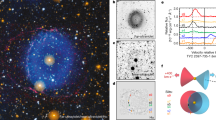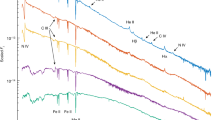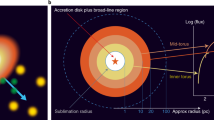Abstract
The nuclear region of the Sc galaxy NGC2903 exhibits a very chaotic structure with eight knots, described by Sandage2 as “giant H II regions”. Others3,4 called these knots ‘hot spots’. This nuclear region has a very strong blue and UV emission5–7 and is a 1,420-MHz radio source8. Oka et al.1 made photographic and spectroscopic observations of the central region, giving magnitudes and colour indices for the knots which they designated a–g. Physical conditions and stellar content of the 3-arc s central region were investigated by Alloin10 whereas Turnrose11 analysed the stellar population in the knot c. The nucleus was identified on near IR photographs9. During high resolution—broad band and narrow band—photometric studies of the central region of NGC2903, we have observed and report here that one of the knots (a, according to Oka et al.1) appears 1.3 mag brighter on plates taken in February 1980 than on a plate taken in January 1978, which agrees with other observations taken1 in 1966–68.
This is a preview of subscription content, access via your institution
Access options
Subscribe to this journal
Receive 51 print issues and online access
$199.00 per year
only $3.90 per issue
Buy this article
- Purchase on Springer Link
- Instant access to full article PDF
Prices may be subject to local taxes which are calculated during checkout
Similar content being viewed by others
References
Oka, S., Wakamatsu, K., Sakka, K., Nishida, M. & Jugaku, J. Publ. astr. Soc. Jap. 26, 289–298 (1974).
Sandage, A. R. The Hubble Atlas of Galaxies (Carnegie Institution of Washington, Washington DC, 1961).
Sérsic, J.-L. & Pastoriza, M. Publ astr. Soc. Pacif. 79, 152–155 (1967).
Sérsic, J.-L. Publ astr. Soc. Pacif. 85, 103–104 (1973).
Tifft, W. G. Astr. J. 66, 390–404 (1961).
Tifft, W. G. Astr. J. 74, 354–365 (1979).
de Vaucouleurs, G. Astrophys. J. Suppl. 5, 233–289 (1961).
Lequeux, J. Astr. Astrophys. 15, 30–41 (1971).
Prabhu, T. P. Astrophys. Space Sci. 68, 519–523 (1980).
Alloin, D. Astr. Astrophys. 27, 433–448 (1973).
Turnrose, B. E. Astrophys. J. 210, 33–57 (1976).
Jones, W. B., Obbits, D. L., Gallet, R. M. & de Vaucouleurs, G. Publ. astr. Dept Univ. Tex., Austin, Ser II, Vol. 1 (1967).
Davoust, E., Nieto, J.-L. & Paturel, G. Colloq. Photométrie Bidimensionnelle, Toulouse (in the press).
de Vaucouleurs, G. Astrophys. J. 227, 729–755 (1979).
Barbon, R., Ciatti, F. & Rosino, L. Astr. Astrophys. 72, 287–292 (1979).
Tifft, W. G. Astr. J. 68, 302–318 (1963).
Alloin, D. Astr. Astrophys. 33, 337–342 (1974).
Alloin, D. & Sareyan, J.-P. Astr. Astrophys. 33, 331–336 (1974).
Alloin, D. & Kunth, D. Astr. Astrophys. 71, 335–343 (1979).
Osmer, P. S., Smith, M. G. & Weedman, D. W. Astrophys. J. 192, 279–291 (1974).
Wood, R. & Andrews, P. J. Mon. Not. R. astr. Soc. 167, 13–29 (1974).
Author information
Authors and Affiliations
Rights and permissions
About this article
Cite this article
Laques, P., Nieto, JL., Vidal, JL. et al. Brightening of a hot spot in NCG2903. Nature 288, 145–146 (1980). https://doi.org/10.1038/288145a0
Received:
Accepted:
Issue Date:
DOI: https://doi.org/10.1038/288145a0
Comments
By submitting a comment you agree to abide by our Terms and Community Guidelines. If you find something abusive or that does not comply with our terms or guidelines please flag it as inappropriate.



